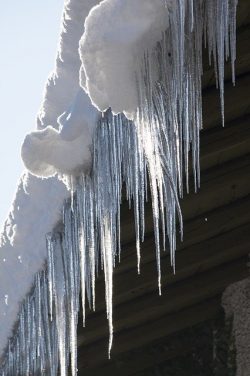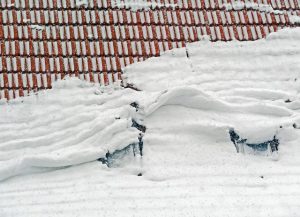In order to prevent the formation of ice dams, you need to know several things. For starters, you need to learn how they are formed to know your enemy and how to keep it away from your home. Then you need to know how much damage they can cause to remain vigilant. A roofer can fix your problem but truth be told, ice dams can cause some serious headaches. Who wants the expense and hassle, especially if you can take some measures to prevent ice dams from forming on your roof?
Ice dams: know your enemy up on your roof
 You don’t need to climb up in the roof to meet your enemy. Ice dams are the icicles you see hanging from the edge of your roof. Their shape resembles that of stalactites.
You don’t need to climb up in the roof to meet your enemy. Ice dams are the icicles you see hanging from the edge of your roof. Their shape resembles that of stalactites.
How ice dams are formed
Ice dams are water. They are formed in locations, which experience really low temperatures and regular snowfall. Ice dams are formed when the indoor heat affects the roof. When this happens and there’s snow on the roof, the higher parts of the roof will be above the freezing point resulting to the melting of the snow. But as the melting snow runs down the slope of the roof, it freezes again due to the lower than freezing temps at this part of the roof. And so, the ice dams are formed.
The dangers of ice dams
The ice dams hang from the eaves of the roof and get bigger. At the same time, the water behind the ice dams is trapped there and usually ends up leaking into the home. The results are obvious: water damage, roof damage, roof components saturation, mold growth.
As if these problems weren’t serious enough, ice dams can cause even more headaches. First of all, they are very heavy. If, for any reason, they break and fall, they might cause severe accidents or damage. Due to their weight, they also cause extra strain to the gutters that may come loose or even become damaged.
Intrigued to discover how to prevent ice dams? Let’s see.
• Ventilation
There’s a need for adequate attic ventilation so that the roof won’t warm up. You need to talk to your roofing contractor about this. Some homes have poor attic ventilation, some none. The thing you need to remember is that the attic must not be heated. If the higher part of the roof (right over the attic) gets even a little bit warmer than the outside temps, the snow will melt and ice dams will form.
• Insulation
With proper attic insulation, this part of the house won’t be affected by the heater. Plus, it will lower your utility bills. To achieve the best results, make sure the attic is properly sealed too.
Will this work?
Will the combination of attic ventilation, insulation, and sealing really keep ice dams from forming? It will certainly make a huge difference. If the roof is not warmed up and snow doesn’t melt to refreeze, ice dams won’t form. But if the weather really gets bad and you raise the temps of your heater indoors, or there’s some heat loss, there’s still a chance of ice dam formation.
Alternative ways to avoid ice dam formation
Then again, if the mountain will not come to Muhammad, there are alternatives. If you cannot decrease heat in the attic efficiently, you can increase coolness. That’s by having an energy loss audit to see which are the parts that let heat escape to the attic. Or make sure that the kitchen vents don’t end up in the attic.
The casual ways to prevent ice dam formation is to shovel snow off your roof. But remember roof snow removal is not easy, or safe. It’s best to call the roofers. Perhaps that old method of removing snow off the roof is the best thing you can do if there’s no money to improve the attic ventilation right now. After all, the whole point is to keep ice dams from forming and that can happen if there’s no snow on your roof. Should you call a roofing company today?
roof. But remember roof snow removal is not easy, or safe. It’s best to call the roofers. Perhaps that old method of removing snow off the roof is the best thing you can do if there’s no money to improve the attic ventilation right now. After all, the whole point is to keep ice dams from forming and that can happen if there’s no snow on your roof. Should you call a roofing company today?


